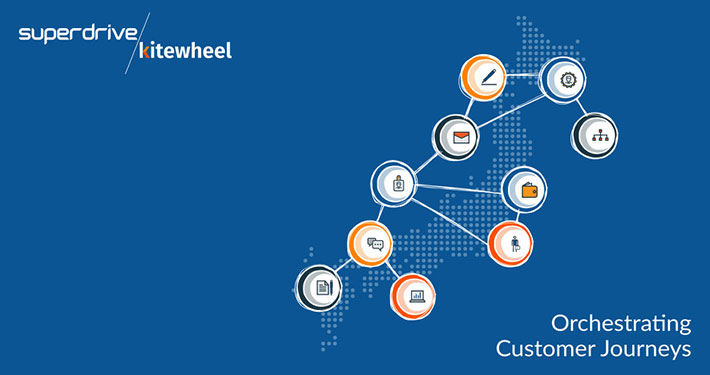In an effort to try and map out the future, Marketo and The Economist have teamed up to offer some insights and advice by talking with some of the best marketing minds out there. What follows is the first of these; this one with Seth Godin.
For those of you that don’t know Seth, he is a renowned thought leader who writes about the post-industrial revolution, the way ideas spread, marketing, quitting, leadership and most of all, changing everything. He is the founder of squidoo.com, and his blog is one of the most popular in the world. He was hired by Yahoo! as Vice-President of Direct Marketing after selling them the start-up, Yoyodyne. In 2013, Mr. Godin was inducted into the Direct Marketing Hall of Fame, one of three chosen for this honor. His latest book, “The Icarus Deception”, argues that we have been brainwashed by industrial propaganda, pushing us to stand out, not to fit in.
There are a bunch of great points and stories in this discussion, so I encourage you to give it a read.
1. The shift to the era of engagement marketing and away from transactional and mass marketing is well underway.
Seth notes this fact when he says “For 100 years, marketing and advertising was the same thing…” and that “…we have seen marketing change from spending money to interrupt people with advertising”. Interestingly, he also says that “the problem is that a lot of marketers didn’t get that memo…” and that those marketers “…want it to go back to the way it was”. It’s clear that’s not going to happen and that marketers need to move towards a model of engagement that is centered on building personalized, lifelong relationships.
2. Marketers need to step up and drive the change toward an engagement model across the organization.
As I mentioned in my last post, this new era puts the marketer squarely in the driver’s seat within an organization — I called it a ‘marketing first’ world. I was struck when Seth pointed out that “marketing has completely transformed”, and that “the marketer now needs to be in charge of everything a company does… they need to be the first step”. Wow! And…here, here!
3. In order to be truly engaging, marketers need to create a continuous, authentic relationship.
Seth talks about how the explosion of channels has created a problematic land-grab effect for marketers who look to ‘own’ a channel. I agree with him when he says that this is a mistake and that you shouldn’t focus on “owning a channel”. True engagement comes from authentic, consistent participation across the channels your audience uses. Instead, use these channels — in Seth’s words — as a “new way to communicate… the truth about who you are”, and deliver “…an experience that people can’t help talking about”.
Enjoy the interview….
Economist Intelligence Unit (EIU): Marketing has changed so much in the past five years. What do you think will happen in the next five? What will the marketer’s mission look like in 2020?
Seth Godin: If we were talking about what is going to be the future of the dried plum, we would have a straightforward conversation. Everyone can agree on what a dried plum is. Not everyone agrees on what marketing is. So before I talk about where it’s going, we have to talk for at least a minute about where it’s been so we understand that we’re starting from the same place.
For 100 years, marketing and advertising was the same thing. The CMO didn’t decide on the product line or pricing or what the toxic waste policy should be. Instead, the measure of marketing has traditionally been, “How much money are you spending on advertising?”
Only in the last 20 years have we seen marketing change from spending money to interrupt people with advertising to market everything you make and everything you say. That involves making a promise to people about what they should expect when they do business with you.
The problem is that a lot of marketers didn’t get that memo. And a lot of marketers — mostly those who work for companies built on advertising mass products to mass audiences — want marketing to go back to what it was. And so when they see YouTube or Twitter come along, they think “This is just like a magazine except the ads are free. This is just like television except the ads are free”. And those people have been pretty generally disappointed with everything that’s happened recently because they’re still working as if marketing equals advertising.
Here’s the answer to your question: I think the next five years of marketing are going to be just like the last five years of marketing but more so. We’ll see the end of almost every newspaper. We’ll see the crumbling of the TV-industrial complex in which TV ads are always sold out. And we’re going to see even more relianceby consumers on peer-to-peer connections and less on the message they hear directly from the marketer.
EIU: So what are the most effective marketers going to be doing five years from now? What do they need todo now to make sure they don’t get passed by as marketing changes?
Seth Godin: The short answer is five words long: “Make things worth talking about”. The longer answer is that the marketer now needs to be in charge of everything the company does. And the ad agency isn’t the last step of the process anymore; it needs to be the first step.
You know the people who used to spend all their time spinning products when they’re released? They need to spend their time at the beginning. They need to be saying, “What should we make? How do we make it in such a way that the story of our product is true?” Look at Nike. Nike is not afraid to spend hundreds of millions of dollars on the products they make, and not on the billboards that they rent.
EIU: So it sounds like there are two kinds of marketers. There are marketers who cling to pushing products with advertising and there are marketers who are embedded in what the company makes and are pushing it towards what the consumer wants.
Seth Godin: That’s exactly right. Most marketers have come froman environment where everyone is selling exactly the same product. The way you won was with a clever tag line. That is the world of “Mad Men”. Modern marketers say, “Well, of course Apple people are waiting in line to hear Apple’s announcement because they’re actually doing something new. They’re not just spinning the old”.
It’s a huge shift. Changes like this haven’t happened elsewhere in the company. Accounting hasn’t changed. Product development hasn’t changed much. Sales isn’t so different, but marketing has been completely transformed.
EIU: I’m interested to hear what you think about the multiplication and fragmentation of channels. Ten years ago Facebook had under a million users. Now it has over a billion, Twitter has half a billion, even Pinterest is approaching 100 million. And all of them are generating big data, enabling predictive analytics, feeding into marketing automation with a lot of personalization. People call them channels, but broadcast media like billboards or TV ads were channels. These seem like much more. How are they going to be affecting marketers?
Seth Godin: Think about someone who goes to a new high school, think of all the channels there are at the new high school. There are the yearbook, the daily announcements, the school newspaper, people talking to each other at lunch. We can make a list of 1,000 ways the people at school are finding things out.
But the new kid at school isn’t a brand manager. The new kid at school isn’t saying, “How do I own this channel, and how do I own that channel?” The new kid at school is saying, “Who do I want to be? Because if I act like the person I want to be, the word will get out”.
And so you can’t really think of a channel as a choke point, where if you spend some money you can own that choke point. Instead, go in the opposite direction. All of these new ways of communicating mean that the more you act a certain way, the more likely it is that the truth will get out about who you are.
EIU: Isn’t the job of marketers to push out their self-definition through all of the channels?
Seth Godin: They can try, but it’s not working. Just call up the people at Procter & Gamble or the people inthe Republican or the Democratic Party and say, “How are you doing on pushing out the message you want everyone to be saying?” And what they brag about is, “Oh, look how great that Oreo thing was”. One Tweet got seen by everyone during the Super Bowl.
But one tweet about Oreos doesn’t sell a single extra Oreo. What marketers have to understand is that mass marketing was a brilliant and important way of supporting mass manufacturing. It was one of the key elements of the growth of the UK and US economies. For 100 years mass marketing sat right next to mass manufacturing. But now it’s over. It is just over. Mass manufacturing is over and mass marketing is over. And you can do all sorts of things to try to get it to come back, but it’s not going to come back.
EIU: So if the marketer isn’t pushing out a message through those channels, what is marketing doing with them? You say that word will get out. What’s the marketer’s role in getting the word out?
Seth Godin: Their role is coming up with an experience, an environment, a service, a product, that people can’t help talking about, and then consistently delivering on that.
Say you start a real boutique hotel. Then you make sure the right people are staying there in the first few weeks. Word gets out among their circle of friends, who talk to the next circleand the next, and the hotel is soldout. Or you can start a fake boutique hotel, which Hyatt Hotel is trying to do. You skip all those steps and make it look like a boutique hotel. Andthen you’re puzzled and surprised when there isn’t a line out the door.
The reason there isn’t a line out the door is that the people you were hoping to connect with can tell that it’s not a real boutique hotel.
EIU: What’s engagement marketing? How does it differ from otherways of relating to customers?
Seth Godin: Here’s an experience that we’ve all had. You call a big company. You hear a recording that says, “Your call is very important to us, but due to unusually heavy call volume, we don’t have anyone to answer your call”, and they put you on hold for ten minutes. Then the person who answers the phone is measured on how fast they get you to hang up.
That’s the opposite of customer engagement. This company spent a lot of time and money to set up a phone queuing system. Then when you talk to them, they don’t care enough to talk back, or if they do talk back, they put someone in your face who has been programmed to be a cog in a machine.
If you’re serious about engaging the customer, you realize that the most valuable moments you have are when the customer is using your product, on the phone with you, actually engaged with you. If we over invest in that, or do what feels like over investing, we are far more likely to lead to the other sorts of interactions that we can’t buy, that we can’t control, but that we need desperately to happen.
EIU: Marketers have responsibility for every part of the company with which the customer comes into contact. Yet they don’t have the authority to determine what happens there. They’re influencers. In fact, in some companies that are dominated by engineering or operations, they struggle for influence.
Seth Godin: I don’t buy that. Your premise is wrong. If you start listing successful companies, almost all of them are run by people who do what I call marketing.
EIU: But all the parts of the company that engage with the customer or that have customer-facing responsibilities don’t report to the marketer. How do marketers orchestrate those customer touch points while they’re not in charge of all those people?
Seth Godin: Nobody’s in charge of everyone. Even the CEO. Influence is way more important than authority.
The first half of the answer is that you need to build influence. You gain influence as you give up more credit and take on more responsibility. The second half is that marketers need to make an effort to not sell out so cheap. What marketers usually do is accept the budget, accept the product and promise the world. That’s why they get fired so much. On average, the CMO gets fired every year and a half, because they make big promises and can’t keep them. They’re unable to keep them because they think advertising can save the day, and it can’t. What I propose they do instead is refuse to market products that they don’t believe in.
The CMO needs to refuse to have their team push work out the door for stuff that doesn’t keep the story consistent and worth telling. Toyota let a worker stop the whole assembly line because the quality of a spark plug was off. That’s what marketers need to do. They need to hit the button and say, “No, we’re not going do this anymore because the customer service people are letting us down when they answer the phone” or “We’re not going to do this anymore because I’ve seen the waste going into the river and I don’t want to be responsible for marketing that brand”.
Spinning for the wrong cause is beneath you. Once the CMO does this, everything upstream will improve. And to the marketer who says to me, “But I can’t do that cause they won’t listen,” I say, “Go work somewhere else. Because if you’ve got talent, doing good spin for a company that doesn’t get it is beneath you”.
EIU: How can you tell when a customer is engaged? What kinds of tangible metrics can show the impact of customer engagement?
Seth Godin: I don’t have a glib answer. Any mass metric is going to be false. I’ll give you an example: Six weeks ago I fired the New York Times. I said, “I don’t want to be on the New York Times Best Seller List anymore because it’s a false metric that’s usually gamed and doesn’t represent the post-mass-marketing world. Rather than ask for rating points or share of mind, I would ask questions like “Who would miss me if I was gone? With whom do I actually have permission to follow up? How many people call us on the phone asking when our new thing is going to be ready?” Those questions show depth of feeling and concern. If you want to be meaningful, you can’t be too general.
EIU: So you’ve got this asset called customer engagement. You’ve invested in it and built it up andyou can measure it in various ways. How would you talk to a CFO about that? When he asks for the ROI, do you think you could tell him?
Seth Godin: When I invented email marketing in 1990, I went to every big company you can think of and tried to sell them on what we had built. And they would say, “What’s the ROI?” Well, my first answer was “What’s the ROI on that TV ad you ran last night? You don’t know. And you’ve been running TV for years because it feels safe. And you like the fact that you can’t measure how well it works because then you don’t have to take the blame for it not working”.
If you’re a really good direct marketer, you make money for a while. But I think we’re moving into a post-direct marketing world where we can’t measure ROI. But we can measure whether you are gaining market share and profit because you’re making great stuff. When everything is driven by metrics you often end up in a race to the bottom, and the problem with the race to the bottom is that you might win. Instead, some people decide to race to the top — not just in pricing, but in terms of the usefulness of what they make and how much fun it is to talk about it. Those people are doing great.
I think that’s the challenge of the CMO. Put the spreadsheet away and do some serious work to make stories worth telling.
EIU: Do you think the group that’s racing to the top through customer engagement is growing compared with those who are racing to the bottom?
Seth Godin: CEOs care a lot about stock price, and what they’re seeing again and again is that Sears is cratering because Sears was focused 100% on spreadsheets, whereas a brand like Apple, which is a mass brand in the sense that they have big market share, is hiring people from the larger consumer goods industry. They understand that in a retail environment engagement matters more than giving people a coupon.
This article has been extracted from Next Era of Marketing site. Please feel free to follow this blog series each week.



